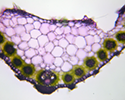
Micro-morphological descriptions on Cenchrus species from Rajasthan (India)
Abstract
Present investigation was carried out to screen micro-morphological features of Cenchrus species (C4 plant) belonging to family Poaceae. This is an important medicinal, fodder as well as crop plant and traditionally used as famine food during drought. It is best suited for desert environmental conditions. In extreme conditions when food is in scarce, seeds of this grass are consumed by tribals. The microscopical illustrations revealed several interesting features i.e. presence of cuticle, bulliform cells, trichomes, lysigenous cavity, more amount of chlorenchyma, Y- shaped vascular bundles, double layered bundle sheath, large vessels and starch grains that support its assimilation efficacy and survival in typical conditions of Thar Desert. This study helps in referential identification, authentication, standardization and detection of adaptation strategies to understand biology of this plant.
Keywords
Full Text:
PDFReferences
Levetin-McMahon. Plants and society. 5th edition, The McGraw-Hill Companies (2008).
Shantz HL. The place of grasslands in the earth’s cover of vegetation. Ecology, 35 (1954) pp. 143–145.
Morrone O, Aagesen L, Scataglini MA, Salariato DL, Denham SS, Chemisquy MA, Sede SM, Giussani LM, Kellogg EA and Zuloaga FO. Phylogeny of the Paniceae (Poaceae: Panicoideae): Integrating plastid DNA sequences and morphology into a new classification. Cladistics, 28.4 (2012) pp. 333 – 356.
Soreng RJ, Peterson PM, Romaschenko K, Davidse G, Zuloaga FO, Judziewicz EJ, Filgueiras TS, Davis JI and Morrone O. A worldwide phylogenetic classification of the Poaceae (Gramineae). Journal of Systematics and Evolution, 53.2 (2015) pp. 117 – 137.
Geetha R. Studies on seed production, processing, dormancy and storage in Blou Buffel (Cenchrus glaucus) cv. CO1. Ph.D. Thesis, Tamilnadu Agricultural University, Coimbatore (2001).
Marshall VM, Lewis MM and Ostendorf B. Buffel grass (Cenchrus ciliaris) as an invader and threat to biodiversity in arid environments: A review. Journal of Arid Environments, 78 (2012) pp. 1-12.
Arora S and Kumar G. Phytochemical screening of root, stem and leaves of Cenchrus biflorus Roxb. Journal of Pharmacognosy & Phytocemistry, 7.1 (2018) pp. 1445-1450.
Arora S, Kumar G and Meena S. GC-MS analysis of bioactive compounds from the whole plant hexane extract of Cenchrus setigerus Vahl. Pharma Science Monitor, 8.4 (2017) pp. 137-146.
Katewa SS, Guria BD and Jain A. Ethnomedicinal and obnoxious grasses of Rajasthan, India. Journal of Ethnopharmacology, 76.3 (2001) pp. 293-297.
Duke JA. Cenchrus ciliaris L. Handbook of Energy crops, unpublished, Center for New Crops & Plants Products, Purdue University, Indiana (1983). or http://www.hort/puedue/duke_energy/Cenchrus_ciliaris.html.
Bhandari MM. Flora of Indian Desert, 2nd edition. MPS Repros, Jodhpur. (1978).
Shetty BV, Singh V. Flora of Rajasthan, (Botanical Survey of India) KolKata. (1993).
DOI: https://doi.org/10.21746/aps.2018.7.3.8
Copyright (c) 2018 Annals of Plant Sciences

This work is licensed under a Creative Commons Attribution-NonCommercial-NoDerivatives 4.0 International License.


